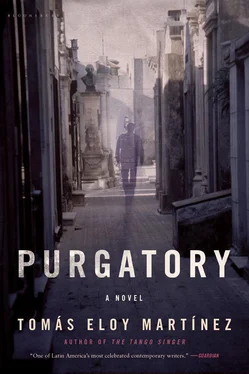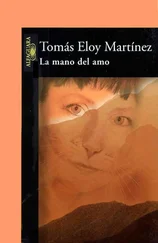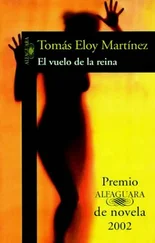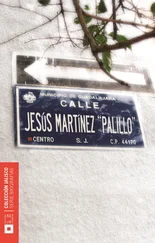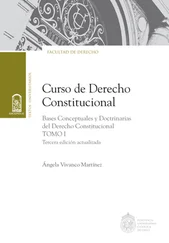Nora Balmaceda basked for a little longer in her rapturous success, dealt with the avalanche of foreign publishers begging to translate her books. In the midst of this frenzied whirl of success, she committed suicide by taking cyanide. She left no letter, no explanation and no will. Before she lay down to die, she put on a white organza blouse and made herself up as though going to a ball. On the nightstand there were two other sodium cyanide tablets. Her faded beauty was intact. No one claimed her body. There had been no sightings of her husband since his abduction by aliens and no relatives appeared. Dr Dupuy gave one of his assistants the task of having her buried with modesty and discretion. Later, he called a bishop friend of his and asked that the Church take possession of all her worldly goods.
Stories that would chill the blood continued to circulate about the disappearances that took place during those years. In old bookshops in Buenos Aires, it is still possible to find copies of magazines telling the strange stories — written in the curious mixture of hypocrisy and collusion common to the period — of people who sailed out on the Río de la Plata only to vanish, leaving their abandoned boats adrift. Many, like Nora Balmaceda’s lost husband, were landowners. Before they set out on their last journey, these people bequeathed their lands and factories to the military leaders who had been their friends and protectors. The courts were inundated by lawsuits from siblings and spouses left penniless, but none was successful since the bodies of those missing never appeared. Where there is nothing to see, no one existed, government spokesmen explained. Such doublespeak has since slipped into ordinary speech having been a staple of journalism. Where there is nothing to see, no one existed — these expressions were repeated over and over on the radio and on television. You can sometimes hear them still.
Other, less durable symbols of those times have vanished. The alien spaceships that once lit up the four corners of the heavens never returned. Of the Basilica to Our Lady of Esteco, not even the ruins have survived. All around lie the skeletons of disused trains. There are no villages, no warehouses on the old gravel road which connected the plains of Esteco with distant Buenos Aires. The trucks don’t run any more, the villages have died out and the houses where no one lives are left to ghosts and rats. The one-horse town which, back in the 1970s, was the major market town in the area, was flooded when a dam was built. A number of elderly people refused to leave and took refuge in the church tower where they waited patiently for the waters to rise. A woman managed to climb onto the cross atop the steeple and huddle there. The fishermen who ply the reservoir can still see the rusted cross rising above the glassy waters; there is nothing else.
While I was writing this page, I read an article about a Patagonian lake that disappeared overnight. The lake was situated near the Témpano glacier at 50º south, it was three kilometres wide and five metres deep. Forest rangers last saw it two weeks ago. When they came back, they found only a dry bed with an enormous crack running up to twenty-five metres deep. Some believe the lake evaporated. It’s the first lake ever to disappear into thin air, they said, forgetting that between 1977 and 1978 whole groups of lakes disappeared. This was how the lago de Sabón, the lago Pulgarcito and the lago Sin Regreso were lost, together, with other smaller lakes. At the time, military patrols witnessed them rise like hot-air balloons, shifted by the movement of geological plates, and spill into volcanoes in the Andes. They were erased from the maps and these lost zones were covered with the wavy blue lines that denote impenetrable snows. Foreign map-makers asked if they might have more information about these blank spaces and the Argentinian authorities invariably responded with Bishop Berkeley’s observation: ‘If it be not perceived, it exists not.’
Their first meeting after thirty years goes just as Emilia imagined so many times. Simón says the very words Emilia dreamed he would say; he moves as though his body has limits that he cannot go beyond. Aside from that, everything is calm, unsurprising. ‘Is it you, Simón?’ she asked him. ‘Is it really you?’ and as she climbed the stairs she reached back and took his hand. The hand seems frail, lighter than she remembers it, smoother too. She hears him say: ‘I never stopped loving you, Emilia, not for a single day.’ She replies, ‘Me neither, amor . Not for a single day.’ At that moment she decides she will ask him to stay. She desperately wants him to linger in the eternity of love she has prepared for him, wants him to undress her now, to satisfy this desire she has concealed from everyone so that he might be the first to know it. When he penetrates her, she wants the world to stop turning, the daylight to pale like the waning moon now rising, for the suffering to cease to suffer, the dead to put an end to death. This is what she wants, but will he want it too? She tells herself again that she should not want him so, with this selfish desire of those who have nothing, who can give nothing. She has searched for him until she was left without breath, without being, but who knows whether he searched for her with the same fervour, who knows what her husband expected to find? Thirty years have passed and they have many stories to tell each other. She wants to begin with the thing that worries her most.
‘Sit down, Simón. Could you do me a favour and sit down for a minute, my love? I’m not the person I was when you left and it’s important that you understand.’
‘I didn’t leave you,’ he says, ‘I’m here.’
He speaks as though age, which has spared his body, has taken refuge in his vocal cords, his voice is stripped of the authority it had when he was chatting with his European friends in Trudy Tuesday. It doesn’t surprise her. Time is like water: when it ebbs in one place it flows somewhere else. This is precisely what she wants to talk to him about. Until a moment ago, all she wanted was to say nothing, to hold him. To lie down beside him and hold him. But the lost years fill her with doubts. She is afraid that if she tells him they are not the people they once where, she might sever the slender thread by which they are now connected. She doesn’t want to hurt him, doesn’t want to hurt herself, and this is precisely why she cannot control what she says.
‘You’re here because you pitied me because I searched for you so long. I combed every city where you were seen. I spent months in Rio de Janeiro, years in Caracas and in Mexico. I came here to this suburb because I couldn’t keep searching any more.’
‘I wasn’t in any of those cities. You looked for me in places where I never was.’
‘Then tell me where you were, tell me where I should have looked. What I want to say to you is that, all the while I was searching, I was growing old. I don’t know how to make you see what I can’t see myself. I’m the same person I was when we fell in love, I feel the same passion, I’m still the same romantic, I still love flowers though no one gives me flowers any more, I love the same music I loved then, and when I go to the cinema, it feels as though you’re sitting next to me, holding me, feeling what I feel.’
‘But we’re not the same people.’
‘That’s what I was coming to. I’m the same person I was, but my body is not the same. Life has made me younger, but my body has gone the way of every woman’s body.’
She asks him if he would like tea. She puts water on to boil and takes down two cups and a tray. ‘Lemon? Sugar?’ This is how she likes her tea. As does he, she knows that already. The sky is heavy with clouds swollen with rain. Night is about to fall, as all things which belong to the natural order falls. Emilia will not see it fall because some days ago, tired of having the students next door peering in at her, she covered the windows with adhesive paper. She finds it unbearable to have to expose her failing, fading body to the eyes of heartless strangers.
Читать дальше
